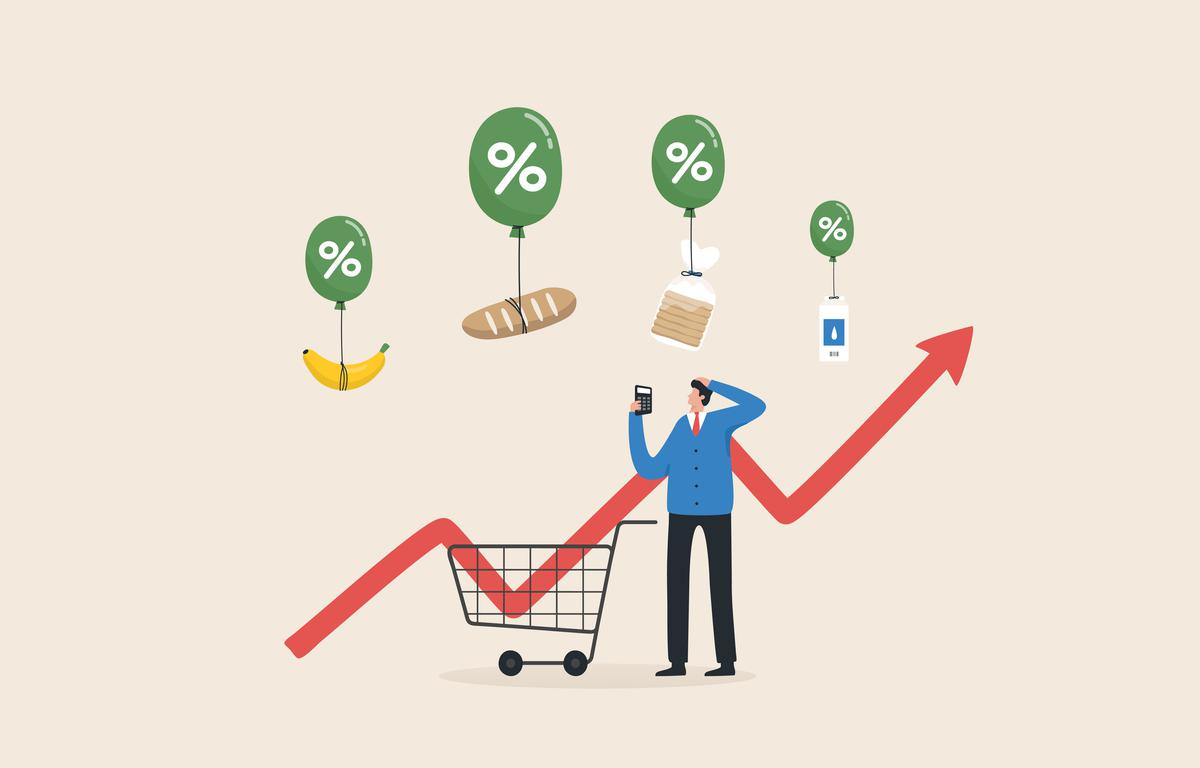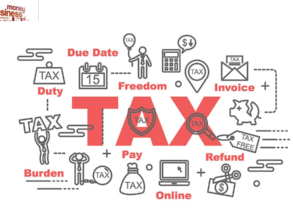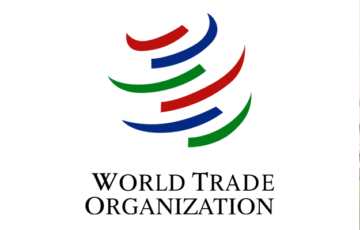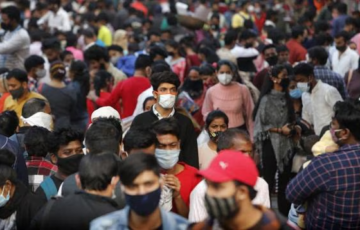INFLATION
Concept of Inflation
- Inflation is the general rise in prices of everyday goods and services, such as food, clothing, housing, and transportation, leading to a decrease in the purchasing power of a nation’s currency. It is commonly expressed as a percentage indicating how much the general level of prices has risen over a given period. Inflation can also be measured through the change in the Wholesale Price Index (WPI) from one year to the next.
- The occurrence of inflation is attributed to an imbalance between supply and demand for money, changes in production and distribution costs, or an increase in taxes on products. To calculate inflation, a basket of goods and services is used, tracking the average price change over time.
Concept of Deflation
- Deflation, on the other hand, is characterized by a fall in prices. While it might seem beneficial, deflation is often associated with economic downturns, reduced productivity, and job losses. It increases the purchasing power of money, encouraging saving rather than spending, which can lead to further economic slowdown. During deflation, money’s value increases, making goods cheaper; however, earnings may decrease due to the economic slowdown.
Comparison between inflation and deflation.
| Parameter | Inflation | Deflation |
| Definition | Inflation is when the value of money falls in the international market. | Deflation occurs when the value of money rises in the international market. |
| Results | General increase in the price levels
Unequal distribution of income Decrease in the purchasing power of currency. |
General decrease in the price levels
Increase in the unemployment level Increase in the purchasing power of currency. |
| Effect on National Income | No impact on national income. | National income decreases in deflation. |
| Benefits | Producers benefit as they can often increase prices to cover or exceed the rate of inflation, leading to potentially higher profits. | Consumers benefit as their money can buy more goods and services due to lower prices, leading to increased purchasing power. |
| In Totality | Healthy and mild inflation is considered a sign of good economic growth, as it often accompanies expansion in employment and investment. | Deflation is not seen as a positive indicator for the economy because it can lead to a downward economic spiral, with increasing unemployment and lower spending. |
Concepts Related to Inflation
- Disinflation: A slowdown in the rate of inflation, where price increases become less rapid. It’s different from deflation because prices are still rising, just at a slower pace.
- Stagflation: A situation where the economy experiences stagnation (slow growth and high unemployment) alongside inflation. It is considered detrimental to economic health.
- Skewflation: Inflation affecting a specific sector or commodity while overall price levels remain stable.
- Reflation: Policies aimed at stimulating economic growth to combat deflationary pressures, often through fiscal or monetary measures.
- Giffen Goods: Products that see an increase in demand as their prices rise, defying the typical law of demand. These are usually essential, low-cost goods.
- Phillips Curve: Demonstrates an inverse relationship between unemployment and inflation, suggesting that lower unemployment comes with higher inflation, and vice versa.
- Engel’s Law: Indicates that as household income rises, the percentage of income spent on food decreases, with more spent on non-essential goods.
- Inflation Tax: The erosion of the value of money held by the public due to inflation, effectively acting as a tax on holding money.
- Inflationary Gap: Occurs when aggregate demand exceeds aggregate supply at full employment, leading to inflation.
- Deflationary Gap: The difference between what an economy is producing at full employment and its actual output, often visible in recessions.
- Deflationary Spiral: A situation where decreasing prices lead to lower production, wages, and demand, further driving prices down, potentially causing economic downturn.
CAUSES OF INFLATION
Demand-pull inflation and cost-push inflation are two main types of inflation
| Aspect | Demand-Pull Inflation | Cost-Push Inflation |
| Definition | Occurs when aggregate demand in an economy outpaces aggregate supply, leading to an increase in prices due to the higher demand for goods and services. | Arises when the cost of production for firms increases, leading to an increase in prices of goods and services to maintain profit margins. |
| Causes | Fiscal Stimulus: Increased government spending.
Population Pressure: A growing population increases demand for goods and services. Increase in Net Exports: Higher demand for a country’s exports. Monetary Stimulus: Lower interest rates increase borrowing and spending. Policy Decisions: Policies that boost consumer confidence and spending. |
Employees’ Salaries Being Raised: Higher wages increase production costs.
Raw Material Prices Increasing: Higher costs of inputs for production. Firms’ Profit Margins: Companies increasing prices to maintain or increase profit margins. Import Prices: Higher costs of imported goods. Increase in Indirect Taxes: Taxes on goods and services increase production costs. |
| Characteristics | Often associated with a booming economy.
Characterized by high employment levels. Can be stimulated by expansionary fiscal or monetary policies. |
Typically results from supply-side shocks.
Can lead to stagflation (stagnant growth with inflation). Less influenced by demand-side policies. |
| Control Measures | Tightening fiscal policy (reducing government spending, increasing taxes).
Tightening monetary policy (increasing interest rates to reduce borrowing and spending). |
Policies aimed at reducing production costs (subsidies for raw materials, tax relief).
Encouraging competition to reduce monopoly pricing power. Exchange rate policies to reduce the cost of imported goods. |
| Examples | A government significantly increases its spending without a corresponding increase in production.
A central bank lowers interest rates, leading to increased consumer borrowing and spending. |
A significant increase in oil prices increases transportation and production costs across the economy.
A natural disaster reduces the supply of raw materials, increasing costs for producers. |
Types of inflation
Cause-Based Inflation
- Demand-pull inflation: This type of inflation occurs when the overall demand for goods and services in an economy exceeds the available supply, leading to an increase in prices. It often happens in growing economies where spending is high.
- Cost-push inflation: It arises when the costs of production for goods and services increase, causing producers to raise prices to maintain profit margins. This increase in production costs can be due to higher wages, more expensive raw materials, or increased taxation.
- Currency inflation: This happens when there’s an excessive printing of currency by a country’s central bank, leading to a surplus of money in the economy. With more money chasing the same amount of goods, prices rise.
- Credit inflation: This form of inflation occurs when there’s an expansion of credit and borrowing in the economy. As more people have access to credit, spending increases, which can push prices up if supply does not keep pace.
- Deficit-induced inflation: This occurs when a government’s spending exceeds its revenue, leading to budget deficits. To finance these deficits, governments may print more money, leading to inflation.
Speed or Intensity-Based Inflation
- Creeping or mild inflation: Characterized by a slow, steady rise in prices, creeping inflation is generally considered beneficial to economic growth, with annual price increases of less than 3%.
- Walking or trotting inflation: This is a moderate level of inflation, with annual price increases between 3% and 10%. It can harm the economy as people may start to buy goods in anticipation of future price increases, further driving up demand and prices.
- Galloping and hyperinflation: When inflation spirals out of control, with rates exceeding 10%, it’s called galloping inflation. Hyperinflation is an extreme form, where prices increase by more than 50% per month. Such levels of inflation can lead to severe economic instability and collapse.
- Stagflation: A situation where high inflation is combined with slow economic growth and high unemployment. It presents a challenge for economic policy since measures to control inflation might exacerbate unemployment.
- Core inflation: This measures the long-term trend in inflation by excluding items that are subject to volatile price movements, specifically food and energy. It provides a clearer view of inflationary trends without the short-term noise.
- Headline inflation: This is a measure of the total inflation within an economy, including all goods and services, even those with volatile prices like food and energy.
Comparison: Headline vs. Core Inflation
- Headline Inflation: Captures the overall change in the price level of a broad set of goods and services in an economy. It reflects the immediate cost pressures faced by consumers.
- Core Inflation: Excludes the prices of food and energy due to their volatility. It is considered a better indicator of long-term inflation trends and is less subject to short-term fluctuations.
Base Effect
- The base effect occurs because the denominator in the calculation of ratios or percentage changes varies, affecting the resulting figure. In essence, when you compare two data points across time, the initial point of comparison (the base) can significantly influence the perceived rate of change. This is particularly relevant for economic indicators that are reported as percentage changes from a previous period.
- Importance of the Base Effect
- Economic Analysis: It helps analysts and policymakers understand the underlying trends in economic indicators by adjusting for distortions caused by the base effect.
- Business Planning: Businesses use an understanding of the base effect to adjust for seasonal variations or other cyclical factors that might affect their performance metrics.
- Investment Decisions: Investors look at growth rates adjusted for base effects to make informed decisions, especially when comparing performance across different time periods.
- Understanding Inflation Rate Calculation
- Example Calculation: If the price of onions rises from ₹10 to ₹15 per kg within a year, the inflation rate for onions would be 50% ((15-10)/10)*100.
- Year-on-Year and Month-on-Month: Inflation rates are calculated both on a year-on-year basis (comparing prices to the same month in the previous year) and month-on-month (comparing prices to the previous month).
- Commodity Groups: Inflation rates are calculated for individual commodities (like onions) and for groups of commodities (like food items).
- Market Variations: Prices can vary significantly between wholesale markets and retail stores, necessitating separate measures for wholesale and retail inflation.
Wholesale Price Index (WPI) vs. Consumer Price Index (CPI)
WPI (Wholesale Price Index):
- Focus: Tracks inflation at the wholesale level.
- Composition: Dominated by prices of manufactured goods.
- Exclusions: Does not account for changes in service prices like haircuts or banking transactions.
CPI (Consumer Price Index):
- Focus: Measures retail inflation, reflecting the price changes consumers experience for goods and services.
- Composition: Dominated by food prices and includes a broad range of services such as transportation, education, personal care, etc.
Comparison and Implications
- Different Baskets: WPI and CPI are based on different baskets of goods and services, tailored to reflect the consumption patterns of their respective audiences (wholesalers for WPI and consumers for CPI).
- Weight Assignments: Different weights are assigned to various goods and services in these indices based on their importance to the respective consumer base.
- Impact of Price Changes: A significant rise in food prices will have a more pronounced effect on CPI (retail inflation) than on WPI (wholesale inflation). Conversely, a spike in the prices of manufactured goods will impact WPI more than CPI.
- Service Price Changes: Changes in the cost of services will affect the CPI but not the WPI, as services are included in the CPI basket.
Why WPI and CPI Differ
- The construction and composition of the WPI and CPI baskets explain why the two inflation rates may differ significantly.
- Since WPI is focused on wholesale prices and heavily weighted towards manufactured goods, it does not capture the price movements in services that impact consumers directly.
- CPI, on the other hand, is more reflective of the cost-of-living changes experienced by consumers, including both goods and services.
- The Wholesale Price Index (WPI) and the Consumer Price Index (CPI) are two important indicators used to measure inflation and the price movement of goods in an economy. Each index has a distinct composition, reflecting the basket of goods and services they monitor.
Key Differences:
- WPI Focus: The Wholesale Price Index primarily focuses on the price movement of goods at a wholesale level, which is why its major components are primary articles, fuel and power, and manufactured products. It does not directly account for services.
- CPI Focus: The Consumer Price Index measures the price movement of goods and services at the consumer level. It covers a wide range of components including food and beverages, pan and tobacco, clothing, housing, fuel and light, and miscellaneous services like education, health, transportation, etc.
Purpose and Use:
- WPI is often used to measure inflation at an early stage of the distribution chain before products reach the retail market. It is useful for understanding trends in wholesale market prices and is often used in adjusting cost escalation clauses in business contracts.
- CPI is more directly relevant to consumers, measuring changes in the price level of a basket of consumer goods and services. It is widely used for indexing pensions, wages, and adjusting policy to manage inflation targeting.
Cost Inflation Index (CII)
- The Cost Inflation Index (CII) is an essential tool used by the Indian tax authorities to measure inflation. It’s specifically applied to adjust the purchase price of certain assets for inflation, thereby calculating the inflation-adjusted cost or indexed cost of acquisition. This adjusted cost is then utilized to determine the real, inflation-adjusted capital gains or losses on the sale of long-term capital assets. The CII helps in ensuring that taxpayers don’t pay capital gains tax on the inflation part of the gains, thus making the tax calculation fairer.
- Notably, CII adjustments are not applicable for calculating gains on equity shares and equity mutual funds, which are taxed at a flat rate of 10% without the benefit of indexation. The Central Board of Direct Taxes (CBDT) updates the CII each fiscal year, with a value of 331 for FY 2022-23, applicable for the assessment year 2023-24.
Producer Price Index (PPI)
- The Producer Price Index (PPI) is a measure indicating the average change over time in the selling prices received by domestic producers for their output. It’s a significant indicator from the perspective of sellers, capturing the price changes before they reach the consumer. Published by the National Statistical Office (NSO), PPI offers benefits such as international comparability, exclusion of supplementary costs like shipping and taxes, providing a clearer view of inflation from the production stage.
Housing Price Index (HPI)
- The Housing Price Index (HPI), published quarterly by the Reserve Bank of India (RBI), tracks the movement of residential property prices across India. Based on verified transaction data from state government registration offices, the HPI serves as an important indicator for the construction sector. It signals when new home constructions become profitable, influenced by the trends in housing prices, and affects factors like bank loan rates.
GDP Deflator
- The GDP deflator is a comprehensive inflation measure reflecting the price changes of all goods and services produced in an economy relative to a base year. It differentiates the part of the GDP growth attributable to increased production from that due to increased prices. Being broader than other inflation measures like the Consumer Price Index (CPI) and Wholesale Price Index (WPI), the GDP deflator automatically accounts for changes in the consumption and investment patterns of an economy. The formula for calculating the GDP price deflator is (nominal GDP/real GDP) × 100. While the CPI and WPI provide monthly data and focus on specific baskets of goods, the GDP deflator offers a more holistic view of inflation across the entire economy, albeit on a quarterly basis.
Inflation Targeting: Recent Update on Fluctuation in Range Of Inflation
- Framework: Inflation targeting operates under a framework where the central bank, such as the Reserve Bank of India (RBI) in India, focuses on keeping inflation within a predefined range. In India, this range is set between 2% and 6%, as per the Flexible Inflation Targeting Framework (FITF) agreed upon in 2016.
- Assumption: The policy is built on the assumption that price stability is fundamental for long-term economic growth. By managing inflation, the central bank aims to create a stable economic environment conducive to investment and consumption.
- Global Adoption: New Zealand was the first country to adopt this approach, and many countries, including India, have since implemented inflation targeting as a cornerstone of their monetary policy.
Recent Update on Fluctuation in Range of Inflation
- Retail Inflation Rise: According to recent data, India’s retail inflation spiked to 7.8% in April, marking the highest increase in eight years and significantly surpassing the RBI’s inflation target. This indicates a substantial rise in the general price level and challenges the effectiveness of inflation targeting.
- Previous Year Question: A question from the 2015 prelims highlighted the roles of the Government of India and the RBI in controlling inflation, emphasizing the multi-faceted approach to managing inflation, which includes monetary policy adjustments and circulation control.
Effects and Consequences of Inflation
- Purchasing Power: High inflation erodes consumers’ purchasing power, reducing the quantity of goods and services that can be bought with the same amount of money.
- Overall Demand: As purchasing power diminishes, consumer demand for goods and services declines, particularly for non-essential items.
- Impact on Savers and Borrowers: High inflation disadvantages savers by diminishing the real interest earned, while borrowers might benefit as the real value of their debts decreases.
- Government Debt Obligations: Inflation can help the government meet its debt obligations by reducing the real value of its debt.
- Corporate Impact: While some corporates may initially benefit from passing on price increases, higher inflation generally reduces demand, impacting sales and profitability, especially for small businesses.
- Exchange Rate and Monetary Policy Response: High inflation can lead to currency depreciation. The RBI’s response, such as increasing interest rates, aims to mitigate inflation’s negative effects and protect the economy.
Measures To Control Inflation
Role of RBI in Inflation Management
The RBI is entrusted with the responsibility of conducting monetary policy with the primary objective of maintaining price stability while fostering economic growth. Key instruments used by the RBI include:
- Repo Rate: The rate at which the RBI lends to commercial banks. Increasing the repo rate makes borrowing more expensive, which can help cool down inflation.
- Reverse Repo Rate: The rate at which the RBI borrows from commercial banks. Adjusting this rate can influence liquidity in the banking system.
- Bank Rate: A longer-term rate affecting the cost of borrowing for banks, influencing overall credit availability in the economy.
- Open Market Operations (OMOs): Buying or selling government securities to adjust the liquidity in the system.
- Statutory Liquidity Ratio (SLR): The percentage of deposits that banks must hold in liquid assets. Increasing SLR reduces the funds available for banks to lend, potentially cooling demand.
- Cash Reserve Ratio (CRR): The share of a bank’s deposits that must be held in reserve with the RBI. Higher CRR reduces the liquidity in the banking system, thereby controlling inflation.
- Liquidity Adjustment Facility (LAF): Allows banks to borrow money through repurchase agreements or lend to the RBI, helping manage liquidity.
- Market Stabilization Scheme (MSS): Issuing treasury bills and government securities to absorb liquidity from the banking system.
Government Measures to Control Inflation
Alongside the RBI’s monetary policy tools, the government can take several steps to tackle inflation, especially when external factors and supply-side constraints are the primary causes:
- Import Agreements: Special agreements, such as purchasing crude oil at discounted rates, can help reduce input costs.
- Increasing Minimum Support Prices (MSPs): To encourage production and increase the availability of food items, potentially moderating food inflation.
- Price Stabilization Fund (PSF): Used to manage price volatility of essential commodities like pulses and onions.
- Action against Hoarding: Enforcement of the Essential Commodities Act and the Prevention of Black-marketing and Maintenance of Supplies of Essential Commodities Act to ensure availability and moderate prices.
- Regular Review Meetings: High-level meetings to monitor prices and availability of essential commodities and take corrective actions as needed. pervious
UPSC PREVIOUS QUESTION PAPERS
1. A rise in general level of prices may be caused by: (2013)
1. an increase in the money supply
2. a decrease in the aggregate level of output
3. an increase in the effective demand
Select the correct answer using the codes given below.
(a) 1 only
(b) 1 and 2 only
(c) 2 and 3 only
(d) 1, 2 and 3
2. Which of the following measures would result in an increase in the money supply in the economy? (2012)
1. Purchase of government securities from the public by the Central Bank
2. Deposit of currency in commercial banks by the public
3. Borrowing by the government from the Central Bank
4. Sale of government securities to the public by the Central Bank
Select the correct answer using the codes given below:
(a) 1 only
(b) 2 and 4 only
(c) 1 and 3
(d) 2, 3 and 4
3. A rapid increase in the rate of inflation is sometimes attributed to the “base effect”. What is “base effect”? (2011)
1. It is the impact of drastic deficiency in supply due to failure of crops
2. It is the impact of the surge in demand due to rapid economic growth
3. It is the impact of the price levels of previous year on the calculation of inflation rate
4. None of the statements (a), (b) and (c) ‘given above is correct in this context
4. With reference to inflation in India, which of the following statements is correct? (2015)
1. Controlling the inflation in India is the responsibility of the Government of India only
2. The Reserve Bank of India has no role in controlling the inflation
3. Decreased money circulation helps in controlling the inflation
4. Increased money circulation helps in controlling the Inflation
5. With reference to the Indian economy, demand-pull inflation can be caused/increased by which of the following? (2021)
1. Expansionary policies
2. Fiscal stimulus
3. Inflation-indexing wages
4. Higher purchasing power
5. Rising interest rates
Select the correct answer using the code given below.
(a) 1, 2 and 4 only
(b) 3, 4 and 5 only
(c) 1, 2, 3 and 5 only
(d) 1, 2, 3, 4 and 5
6. Which one of the following is likely to be the most inflationary in its effects? (2021)
1. Repayment of public debt
2. Borrowing from the public to finance a budget deficit
3. Borrowing from the banks to finance a budget deficit
4. Creation of new money to finance a budget deficit Solution
7. Consider the following statements: (2013)
1. Inflation benefits the debtors.
2. Inflation benefits the bond-holders.
Which of the statements given above is/are correct?
(a) 1 only
(b) 2 only
(c) Both 1 and 2
(d) Neither 1 nor 2
8. India has experienced persistent and high food inflation in the recent past. What could be the reasons? (2011)
1. Due to a gradual switchover to the cultivation of commercial crops, the area under the cultivation of food grains has steadily decreased in the last five years by about 30%.
2. As a consequence of increasing incomes, the consumption patterns of the% people have undergone a significant change.
3. The food supply chain has structural constraints.
Which of the statements given above are correct?
(a) 1 and 2 only
(b) 2 and 3 only
(c) 1 and 3 only
(d) 1, 2 and 3










